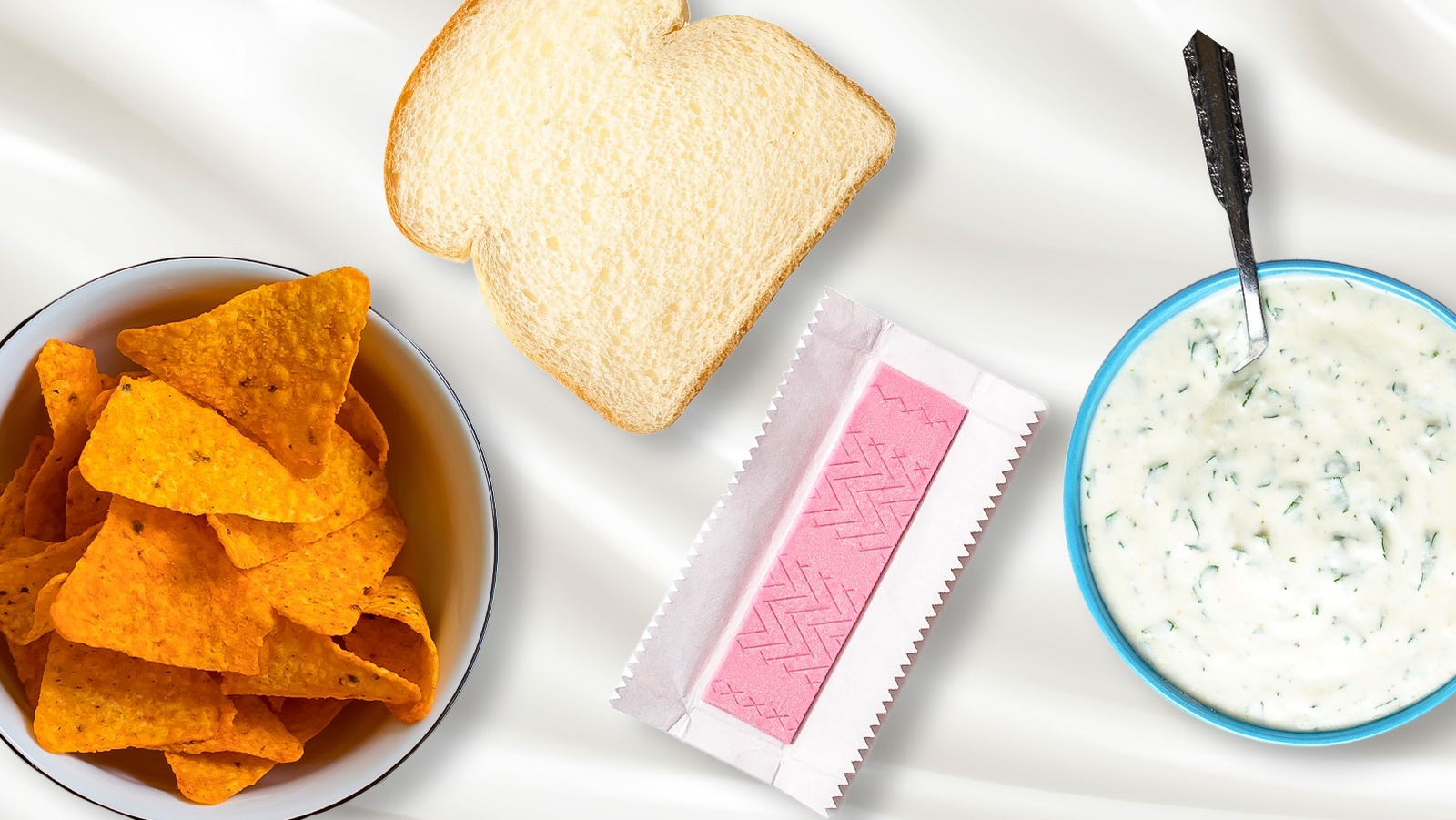There are multiple reasons why dairy-containing foods might not feature in your diet, whether you eat fully plant-based, are lactose intolerant, or suffer from an allergy. And, those in the dairy-free community will know that eliminating such foods isn’t as straightforward as it first seems. Following a dairy-free diet doesn’t simply mean avoiding milk, butter, cream, and cheese. In fact, there are countless products that contain dairy. Some of these are more obvious, such as decadent pre-made cakes and pastries, milk chocolate bars, and creamy soups. But, when browsing products at the store, checking the labels is always recommended, because dairy can also be hiding in some rather surprising places.
From popular snacks and breakfast foods to common fridge staples, dairy has found its way into just about every grocery store aisle, where it often serves as a vital contributor to a product’s taste and texture. In the United States, any item that contains milk is required by law to state this on the label, so this is generally easy to spot. However, other ingredients such as whey, ghee, and casein should also be avoided.
If you’re newly navigating the world of dairy-free eating, we’re here to help. Below are 12 everyday products in which dairy often lurks. These products don’t always have to be avoided completely because there will be exceptions to the rule, but we simply recommend exercising vigilance when taking your pick from the various brands available at the store. So, let’s take a look at some of the most unexpected dairy-laden foods on the market.
Salad dressings
No salad is complete without a flavorful dressing, and many store-bought bottles are safe options for dairy-free eaters. Tangy vinaigrettes are made with oil and vinegar, while plenty of other varieties have a mayonnaise base (yes, mayo is typically dairy-free). You’d therefore think that you can browse the dressing aisle care-free. Unfortunately, not all dressings are suitable for those avoiding dairy.
Take a look at the dressings on offer at the grocery store, and you’ll find that, all too commonly, milk, cheese, or buttermilk are listed as ingredients. These tend to feature in creamy dressings such as ranch, Italian, or Caesar, giving them that tangy taste and luscious consistency. Dairy isn’t always an obvious add-in, though. So, if in doubt, always check the label. Thankfully, there’s a wide range of dairy-free and vegan salad dressing options available at most large grocery stores nowadays, with oils and thickeners doing an excellent job at replicating the richness of dairy products.
It’s also incredibly easy to whip up your own dairy-free salad dressings at home. Try blending up soaked cashews with lemon, garlic, and a medley of different seasonings to create a vegan Caesar dressing. Or, how about an ultra-creamy vegan ranch made with coconut yogurt and tahini? And, of course, a classic herby lemon vinaigrette is always a great idea.
Lactose-free milk
For those who suffer from lactose intolerance, lactose-free milk is a godsend. Taste and texture wise, this product is exactly like regular cow’s milk, and that’s because it still most definitely contains dairy. Lactose-free milk and dairy-free milk are two very different things. To make the former, cow’s milk first undergoes a filtration process, then has an enzyme called lactase added to it. This enzyme works to break down the lactose into glucose and galactose, with the result being milk that’s completely free of lactose but still packed with calcium and protein. Dairy-free milks, however, are typically made from plant-based products, such as soy, almonds, or coconut. They tend to have a very different flavor to regular dairy milk and aren’t always quite as creamy. But opt for these, and you can be safe in the knowledge that there’s not a drop of dairy in sight.
Other widely available lactose-free products include cheese, butter, and yogurt. With these, the situation is the same. Don’t be fooled into thinking they’re dairy-free. Whilst they are fantastic substitutes if lactose intolerance is your only concern, they’re still 100% dairy-based and not suitable for consumption as part of a dairy-free diet.
Gravy
You’ve cooked up a beautiful dairy-free dinner, and you’re reaching for the gravy granules to add a touch of savory goodness. In this situation, you might not think twice about the potential of hidden dairy-containing ingredients since the color, flavor, and texture of gravy don’t really scream dairy at all. However, store-bought mixes, cartons, and jars of gravy aren’t always a safe option. These products can feature dairy in many forms, including whey, caseinate, and buttermilk. Sodium caseinate, in particular, is derived from casein — a protein found in milk. This is sometimes used as a thickening agent in store-bought gravies.
Fortunately, keeping your homemade gravy dairy-free is delightfully easy. Many recipes start with butter, but you can absolutely switch this out for a dairy-free butter alternative or simply opt for a splash of neutral oil instead. Then, you might saute diced onions before adding beef or chicken broth, plus a splash of Worcestershire sauce and some herbs of your choice. But if you’re not ready to give up the convenience of store-bought gravy, that’s no problem. There are still plenty of branded gravies and mixes that don’t include dairy products on the ingredients list. As always, checking the label is your best bet!
Processed meats
Best enjoyed in moderation but undeniably tasty, processed meats are the ultimate savory treat. Whether you’re tossing cold cuts into a sandwich for a delicious on-the-go lunch or grilling sausages at a summer barbecue, these meats are a great way to add flavor and heartiness to your plate. Clearly, processed meats are not vegetarian or vegan-friendly, but something else that’s important to be mindful of is their potential dairy content.
Though meat and dairy are two entirely separate types of animal products, when making processed meats, the two are sometimes combined. Foods like sausages and deli meats will often contain casein (a milk protein) or lactose (a milk sugar). These add-ins can serve as a filler, which increases the volume of the final product and makes it more cost-effective to produce, or an emulsifier, which helps to bind other ingredients together. Some cured meat products also contain milk powder, with lactose playing a vital role in the fermentation process of certain salamis and hams.
Something else to keep in mind when purchasing processed meats is the risk of cross-contamination. Often, manufacturers that produce both meats and cheeses will use the same tools for slicing the two products. This is particularly concerning for those with life-threatening dairy allergies. Many products will, however, feature guidance on the packaging. Look out for phrases like “processed in a facility that also handles milk” and avoid if necessary.
Margarine
Margarine can be used for everything from cake pan-greasing and sauteing to sandwich-making. This trusty spread is usually dairy-free and often vegan-friendly, too. Most margarine products are made with vegetable oils like corn, canola, or palm oil, which are mixed with water, salt, and other flavor and color-enhancing additives. This forms a product that remains solid when refrigerated but is easily spreadable and meltable, making it a convenient option for a range of cooking applications.
However, where most manufacturers use water as the liquid component of margarine, some opt for milk. This, of course, means such products lose their dairy-free status. Additionally, some types of margarine feature other forms of dairy, such as casein, which acts as a binding agent, and whey, which can help to give the spread a creamier texture. So, always keep an eye out for these unexpected ingredients when selecting a tub of margarine at the store, or simply choose one specifically labeled as vegan or dairy-free.
Bread
Traditional or artisan breads are generally free of dairy products. In fact, most are made with just four simple ingredients — flour, yeast, salt, and water. This applies to a variety of other breads as well, including baguettes, pitas breads, and focaccia. But, deviation from this basic formula is common, with dairy making its way into countless bread recipes. In particular, enriched breads like brioche or milk bread will often feature milk or butter as a key ingredient, which helps to give the bread that signature soft, springy texture. Some flatbreads are also made with milk or yogurt as standard, while butter is the go-to in a batch of fluffy pull-apart dinner rolls.
As well as the more obvious milk or butter, we sometimes also see casein, milk powder, and whey listed on store-bought bread labels. A top tip is to look for bread in the fridge or freezer section of smaller health food shops. These are often made with nutrient-rich whole grains, seeds, and legumes and contain fewer artificial additives as well as being dairy-free. For the keen home-bakers amongst us, whipping up your own dairy-free loaf is totally an option, too. If a crusty loaf is your vibe, try our easy French bread recipe. Or, for something a little more rustic, go for a hearty pumpernickel bread.
Some potato chips
Sure, potato chips are mostly made of, well, potatoes! And many chip brands have a variety of dairy-free and vegan-friendly offerings. These salty snacks are typically made by thinly slicing potatoes and then frying them in hot oil until crisp. Next, the chips are tossed in a powdered seasoning mix, with the exact blend depending on the desired flavor. It’s in this flavorful seasoning element where dairy products often lurk. These could come in the form of milk powder or cheese powder, with sour cream being a popular addition, too.
To ensure that your store-bought potato chips are dairy-free, avoid flavors that mention cheese or cream, and always check the labeling for other pesky dairy derivatives. You could even make your own batch of dairy-free kettle chips with the help of a mandolin and a Dutch oven. Just slice the potatoes, drop them into ice water, then dry them off. Then, chill the slices in the fridge while you heat vegetable oil to 350 degrees Fahrenheit in a Dutch oven. Once the oil is up to temperature, drop the potato slices in and fry until perfectly crisp. Finally, drain the chips on kitchen paper for a few minutes before seasoning as desired. You could opt for a simple toss with salt and pepper or go all out with a flavorful spice mixture.
Chewing gum
Chewing gum certainly isn’t one of the first things that comes to mind when thinking of dairy-containing foods, but this is, in fact, another product where label-reading is essential. Historically, chewing gums were made from naturally occurring plant saps, and today, it’s mostly synthetic rubbers and resins that give the gum its signature chewable texture. These base ingredients get mixed with softeners, preservatives, sweeteners, and flavorings to create bite-sized strips or pellets that don’t dissolve or break down in the mouth, encouraging you to chew to your heart’s content.
But where does dairy come in? Well, there’s one rather unusual ingredient that’s cropping up again and again in modern gum recipes. Casein phosphopeptide-amorphous calcium phosphate (or CPP-ACP for short) is a milk-derived compound that’s been shown to have remineralizing and enamel-hardening effects on the teeth. It’s, therefore, sometimes added to chewing gum under the trademarked name “Recaldent.” This enables brands to market their product towards the dental health-savvy, but isn’t so great for consumers with allergies to milk proteins. So, choose your gum with care!
Some breakfast cereals
Perfect for busy mornings, breakfast cereals are wonderfully convenient. There are countless varieties to choose from in the cereal aisle, with most being made from grains like rice, corn, or wheat. Some sit on the more wholesome end of the scale, being lower in sugar and providing a great source of nutrients such as fiber, B vitamins, and iron, while others feel more like a fun sweet treat (Lucky Charms, anyone?). Many, however, do contain dairy.
With so many options on offer, it can be tricky to know which cereals are suitable if you’re following a dairy-free diet. Some will contain milk powder, whey, and casein, which are all derivatives of milk. Unfortunately, the only way to know for sure which products are safe is by having a thorough read of the label, so allow yourself some browsing time to find something suitable for you. You can also check out this list of allergy-friendly cereals by Spokin. And when it comes to serving your chosen cereal, there are plenty of dairy-free milk options to consider, such as almond, oat, or soy milk. Or, try adding a dollop of coconut yogurt to your bowl.
Breadcrumbs
Whether you like to scatter them over a homemade mac and cheese, stir them into a meatball mixture, or use them to coat meat, store-bought breadcrumbs are a valuable addition to any pantry. Frustratingly, this is another food that dairy-fee eaters should be wary of since a large number of handy premade breadcrumb products contain milk or cheese. This is more common with seasoned varieties, such as Italian-style breadcrumbs or Parmesan-spiked panko breadcrumbs. Dairy-free options can certainly be found among the unsuitable products, though. Look for plain or unseasoned types, which are likely to contain fewer ingredients. They can always be jazzed up with the addition of some extra dried herbs and seasonings once you get home.
You can totally make your own dairy-free breadcrumbs from scratch, too. Start by cutting bread into cubes, then popping it in the oven for 10 minutes or so to dry it out. Once cooled, add the bread pieces to a food processor and blitz until broken down into fine crumbs. At this point, stir in any seasonings of choice, such as salt, onion powder, garlic powder, and oregano. The breadcrumbs are ready to use right away but can also be stored in an airtight container at room temperature for up to a month.
Crackers
Pick up a box of crackers, and you’re likely to see some form of milk or butter listed in the ingredients, which isn’t particularly ideal if you’re dairy-free. While many store-bought options are a no-go, this doesn’t mean giving up crackers altogether. Thankfully, there are still a fair few dairy-free cracker brands out there. Look out for natural products with shorter ingredient lists and a hearty base of seeds or grains. These can often be found in smaller health food stores. One fantastic option is crispbread crackers, which are usually made with rye flour and don’t typically contain milk or butter.
We can also highly recommend making your own dairy-free crackers. You’ll need just four base ingredients — all-purpose flour, salt, water, and olive oil. The way you flavor them is down to you, but feel free to add in any seasonings of your choice, such as garlic powder, thyme, black pepper, or even a sprinkling of everything bagel seasoning. Once the dough has been mixed up, roll it out thinly and cut it into squares, rounds, or triangles before baking until golden and crisp. If you’re also avoiding gluten, you can explore other flour alternatives here too. Our delicious garlic and herb crackers feature both almond flour and ground flaxseed for a wholesome but still wonderfully crunchy finish.
Sherbet
Sherbet and sorbet are two frozen treats that frequently get confused with one another. They’re both similar to ice cream, often served with fresh fruits or as an accompanying scoop to another warm dessert. They also both contain fruit, with a range of delicious, vibrant flavors available. There is, however, one key difference here. Sorbet can be made from just two ingredients — that’s the fruit, which tends to be in the form of puree or juice, and sugar syrup. Sometimes, additional flavorings are thrown into the mix, too. This simple ingredient makeup means sorbet is completely dairy-free.
Sherbet, on the other hand, is not usually dairy-free. Here, the fruit is churned with some form of dairy product, such as milk, cream, or condensed milk, and this is exactly what distinguishes it from sorbet. Sherbet still isn’t quite as creamy as traditional ice cream since the percentage of dairy is much lower, but this allows those fruity flavors to shine. So, to keep things dairy-free, reach for sorbet in the freezer aisle. Or, if you have an ice cream maker, have a go at making a dairy-free sherbet by switching out the dairy element for creamy canned coconut milk.





